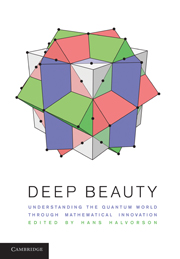Book contents
- Frontmatter
- Contents
- Contributors
- Preface
- Acknowledgments
- Introduction
- I Beyond the Hilbert Space Formalism: Category Theory
- 1 A Prehistory of n-Categorical Physics
- 2 A Universe of Processes and Some of Its Guises
- 3 Topos Methods in the Foundations of Physics
- 4 The Physical Interpretation of Daseinisation
- 5 Classical and Quantum Observables
- 6 Bohrification
- II Beyond the Hilbert Space Formalism: Operator Algebras
- III Behind the Hilbert Space Formalism
- Index
3 - Topos Methods in the Foundations of Physics
from I - Beyond the Hilbert Space Formalism: Category Theory
Published online by Cambridge University Press: 01 June 2011
- Frontmatter
- Contents
- Contributors
- Preface
- Acknowledgments
- Introduction
- I Beyond the Hilbert Space Formalism: Category Theory
- 1 A Prehistory of n-Categorical Physics
- 2 A Universe of Processes and Some of Its Guises
- 3 Topos Methods in the Foundations of Physics
- 4 The Physical Interpretation of Daseinisation
- 5 Classical and Quantum Observables
- 6 Bohrification
- II Beyond the Hilbert Space Formalism: Operator Algebras
- III Behind the Hilbert Space Formalism
- Index
Summary
Introduction
More than forty years have passed since I first became interested in the problem of quantum gravity. During that time, there have been many diversions and, perhaps, some advances. Certainly, the naively optimistic approaches have long been laid to rest, and the schemes that remain have achieved some degree of stability. The original “canonical” program evolved into loop quantum gravity, which has become one of the two major approaches. The other, of course, is string theory—a scheme whose roots lie in the old Veneziano model of hadronic interactions, but whose true value became apparent only after it had been reconceived as a theory of quantum gravity.
However, notwithstanding these hard-won developments, certain issues in quantum gravity transcend any of the current schemes. These involve deep problems of both a mathematical and a philosophical kind and stem from a fundamental paradigm clash between general relativity—the apotheosis of classical physics—and quantum physics.
In general relativity, spacetime “itself” is modeled by a differentiable manifold M, a set whose elements are interpreted as “spacetime points.” The curvature tensor of the pseudo-Riemannian metric on M is then deemed to represent the gravitational field. As a classical theory, the underlying philosophical interpretation is realist: both the spacetime and its points truly “exist,” as does the gravitational field.
- Type
- Chapter
- Information
- Deep BeautyUnderstanding the Quantum World through Mathematical Innovation, pp. 187 - 206Publisher: Cambridge University PressPrint publication year: 2011
- 8
- Cited by



